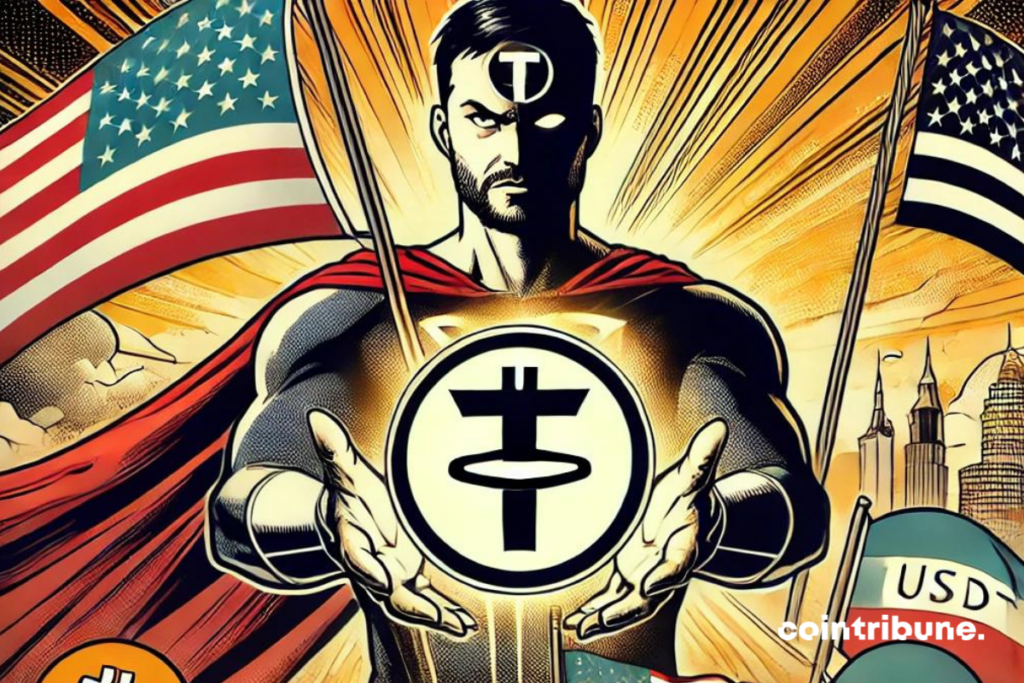Expansion of the BRICS: Can USDT protect the US dollar?
As the BRICS welcome new members and strengthen their de-dollarization agenda, a burning question emerges: could the Tether (USDT) stablecoin be the United States’ secret weapon to preserve their economic hegemony? The implications for the crypto market and the global economy are immense.

The BRICS’ De-Dollarization Efforts
The BRICS group, consisting of Brazil, Russia, India, China, and South Africa, has recently invited Iran to join its ranks. This expansion underscores the growing ambition of these nations to challenge the economic supremacy of the US dollar. Tether CEO Paolo Ardoino recently highlighted the importance of Tether (USDT) in this context. He stated that the USDT “brings the US dollar to hundreds of millions of people around the world living in developing countries who need an alternative to their local currencies“. This statement underscores the potential of USDT to serve as a substitute for the dollar in fragile economies.
BRICS member countries have long considered alternatives to the dollar for cross-border transactions. They have announced the creation of an independent payment system based on digital currencies and blockchain. Furthermore, they are still examining the possibility of implementing a stablecoin to facilitate these transactions. Russian President Vladimir Putin has even hinted that the bloc might explore the use of XRP associated with Ripple for cross-border settlements.
The Potential Role of USDT
Howard Lutnick, CEO of Cantor Fitzgerald, recently emphasized the crucial importance of a dollar-backed stablecoin for the United States, in the face of BRICS’ de-dollarization efforts. According to him, “the digital dollar is more important than ever“. Although he did not explicitly mention which stablecoin the US should adopt, his statements suggest a preference for USDT.
Lutnick’s subtle support for USDT can be seen as a strategy to promote the capabilities of this digital currency and thus strengthen the position of the US dollar against BRICS’ de-dollarization initiatives. By offering a stable and widely accepted alternative, USDT could help maintain the influence of the dollar in a context of increased competition. However, the implications of this approach are manifold and must be carefully examined. The legitimacy and stability of Tether’s reserves are crucial to ensure users’ and investors’ confidence.
Prospects for the future show that the United States will need to adapt and innovate to maintain their monetary supremacy. The growing adoption of stablecoins like USDT in international transactions could play a key role in this strategy.
Maximize your Cointribune experience with our "Read to Earn" program! For every article you read, earn points and access exclusive rewards. Sign up now and start earning benefits.
Diplômé de Sciences Po Toulouse et titulaire d'une certification consultant blockchain délivrée par Alyra, j'ai rejoint l'aventure Cointribune en 2019. Convaincu du potentiel de la blockchain pour transformer de nombreux secteurs de l'économie, j'ai pris l'engagement de sensibiliser et d'informer le grand public sur cet écosystème en constante évolution. Mon objectif est de permettre à chacun de mieux comprendre la blockchain et de saisir les opportunités qu'elle offre. Je m'efforce chaque jour de fournir une analyse objective de l'actualité, de décrypter les tendances du marché, de relayer les dernières innovations technologiques et de mettre en perspective les enjeux économiques et sociétaux de cette révolution en marche.
The views, thoughts, and opinions expressed in this article belong solely to the author, and should not be taken as investment advice. Do your own research before taking any investment decisions.